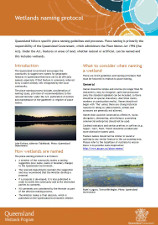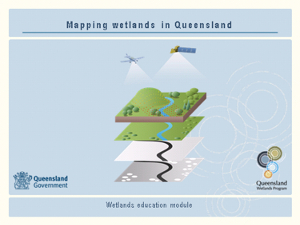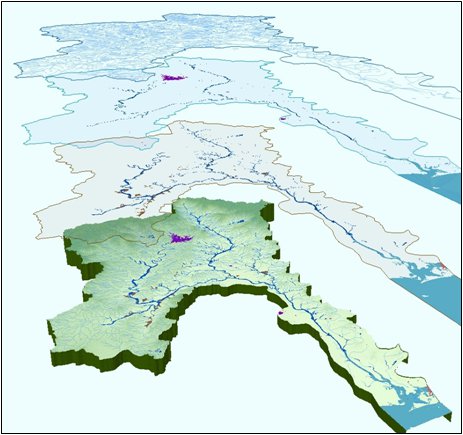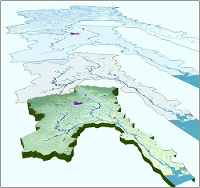|
|
Wetland mapping backgroundWetland mapping at an appropriate scale and level of detail is necessary for decisive wetland management and decision making. Many different styles of wetland maps exist in Queensland—developed at different scales, using different techniques for different purposes. A base wetland map has been developed by the Queensland Wetlands Program to support consistent decision making. Further information
Quick facts
Wetland Mapping
Wetland mapping and data for wetlands in Queensland enable managers to make confident, effective and accurate decisions about the management and care of wetlands. Anyone can use the maps to find out about wetlands generally or to find out about specific wetlands. The Program has developed a consistent wetland map at a scale of 1:100,000, with finer detail in some parts of Queensland (mainly coastal regions). The mapping integrates satellite imagery, regional ecosystems (REs) and topographic. The result is maps of Queensland’s swamps (palustrine wetlands), lakes (lacustrine wetlands), rivers (riverine wetlands), and vegetated intertidal wetlands above mean sea level. The wetland mapping has been updated several times and the present mapping shows the status of wetlands in 2019. The wetland classification system applies a range of attributes to the maps, including the ecological system (lacustrine, palustrine, riverine, intertidal and subtidal), climate region, water type, hydrological modification, water regime, substrate, topography, vegetation and others. The classification system has formed the basis for the Program’s groundbreaking work on wetland typology. The attributes identify wetland habitat types which are linked to the mapping and form the basis for the conceptual models and management profilesQueensland wetland mapping methodA variety of methods have been used to classify and map wetlands in Queensland at a range of scales, for numerous purposes. The Queensland Wetland Mapping Method - A Method to Provide Baseline Mapping of Wetland Extent and Changes in Wetland Extent establishes a consistent, standardised, and repeatable approach to comprehensively map and classify wetlands across Queensland at a minimum 1:100,000 scale to facilitate decision making and management activities. The Queensland Wetland Mapping Method also includes details on how to determine changes in wetland extent (such as loss and gain) which is integrated into the Reef Report Card, Regional Report Cards and the Ecosystem Health Monitoring Programs. These changes in wetland extent are reflected in the data available on WetlandSummary. Wetlands have been mapped digitally by collating, processing, updating, and integrating a range of existing information including regional ecosystem mapping, wetland water body mapping, and drainage network data. The use of multiple existing information sources ensures that wetland mapping data represents the maximum wetland extent integral for the development of baseline data. Maximum wetland extent is the basic unit used for classification and typing. Once delineated, wetlands have been further classified according to a range of attributes, including wetland system (riverine, intertidal etc.), degree of water permanency, salinity and other attributes consistent with the Interim Australian National Aquatic Ecosystem Classification Framework[1]. Information to classify wetlands comes from multiple sources including Geoscience Australia’s Wetland Insight Tool which supports enhanced understanding of wetland hydrology through time. Wetlands have also been grouped into types for general planning and management purposes. The resultant product is a consistent state-wide wetland map at a scale of 1:100,000, with finer detail in some parts of Queensland (mainly coastal regions). The Queensland wetland mapping consists of 3 data sets which need to be combined to show surface wetlands. The result is maps of Queensland’s swamps (palustrine wetlands), lakes (lacustrine wetlands), rivers (riverine wetlands), and vegetated intertidal wetlands above mean sea level. Some wetlands are dependent on groundwater, and groundwater dependent ecosystem mapping is also available for some parts of Queensland. Methods to map and classify intertidal and subtidal ecosystems were developed in 2017 and 2020 and this was applied to map and classify these wetlands in central Queensland. Queensland Wetland Delineation and Mapping GuidelineThe Queensland Wetland Delineation and Mapping Guideline provides information on how to apply the QWP Wetland Definition (the Definition) at a property scale to delineate and map the boundary of a wetland including defining its position, shape, and size. This guideline assists government agencies, land managers, natural resource managers, scientists, surveyors, consultants, and others wanting to delineate and map the boundaries of an identified wetland feature for decision-making and planning purposes. In some cases, requirements for development assessment may advise or stipulate the use of this and other guidelines for regulatory purposes. This document complements the Queensland Wetlands Definition Guideline. Get mapping helpYou can access mapping in many different formats. Step-by-step guides on how to access mapping is available to assist you. Wetland mapping and classification version historySeveral wetland mapping and classification products have been developed and delivered through the Queensland Wetlands Program. The information below provides a history of the versions provided to date. Version 6.0—Displayed on WetlandMaps October 2023. Queensland wetland mapping and classification for the whole state, based on 2019 extent. This includes updated mapping (fixing errors, remapping to finer scale) as well as updating the extent from 2017 to 2019. This dataset provides mapping of wetlands as at 2019 extent at 1:100,000 scale across Queensland. Coastal areas may be mapped at 1:50,000 scale and Brisbane City may be mapped at 1:25,000 scale. Version 5.1—Displayed on WetlandMaps February 2021. This beta version includes Wetlands Insight data which summarises how the amount of open water, wet, green vegetation, dry vegetation and bare soil varies over time within each palustrine or lacustrine wetland. This data is displayed in the form of an interactive graph. Version 5.0—Released November 2019. Queensland wetland mapping and classification for the whole state, based on 2017 extent. This includes updated mapping (fixing errors, remapping to finer scale) as well as updating the extent from 2013 to 2017. Version 4.0—Released September 2015. Queensland wetland mapping and classification for the whole state, based on 2013 extent. This includes updated mapping (fixing errors, remapping to finer scale) as well as updating the extent from 2009 to 2013. Version 3.0—Released February 2012. Queensland wetland mapping and classification for the whole state, based on 2009 extent. This includes updated mapping (fixing errors, remapping to finer scale) as well as updating the extent from 2005 to 2009. Version 2.0—Released September 2009. Queensland wetland mapping and classification for the whole state, based on 2005 extent. This includes updated mapping (fixing errors, remapping to finer scale) as well as updating the extent from 2001 to 2005. Version 1.3—Released February 2009. Queensland wetland mapping and classification for Queensland, based on 2001 extent. This includes updated mapping for areas released in versions 1.0, 1.1 and 1.2, and new mapping for Lake Eyre, the Gulf of Carpentaria, western Cape York Peninsula catchments and South East Queensland. Version 1.2—Released February 2008. Queensland wetland mapping and classification for the Great Barrier Reef, Wide Bay, Cape York Peninsula and Murray-Darling Basin catchments, based on 2001 extent. This includes updated mapping for areas released in versions 1.0 and 1.1, and new mapping for Cape York Peninsula and Murray-Darling Basin catchments. Version 1.1—Released April 2007. Queensland wetland mapping and classification for the Wide Bay catchments, based on 2001 extent. Version 1.0—Released December 2006. Queensland wetland mapping and classification for the Great Barrier Reef catchments between Bundaberg and Cooktown, based on 2001 extent. Data sets—metadata
Wetland naming protocol The Queensland Government encourages the community to suggest new names for geographic features in Queensland that have yet to be officially named. The place naming process includes consideration of naming issues, provision of recommendations to the relevant Minister under the Place Names Act 1994, publication of notices and maintenance of the gazetteer or register of place names. Wetland online education modules A series of online education modules, including Mapping wetlands in Queensland, has been prepared as a resource for people who want to learn more about wetlands. Users can download and use the contents of this education module to meet their learning and training needs. This information should be used in conjunction with information found on this website. This resource outlines the key principles of wetland mapping and should not be used for statutory purpose. Pages under this sectionReferences
Last updated: 12 October 2023 This page should be cited as: Department of Environment, Science and Innovation, Queensland (2023) Wetland mapping background, WetlandInfo website, accessed 18 March 2024. Available at: https://wetlandinfo.des.qld.gov.au/wetlands/facts-maps/wetland-background/ |

 — Department of Environment, Science and Innovation
— Department of Environment, Science and Innovation



